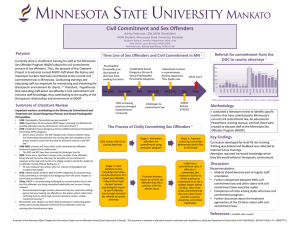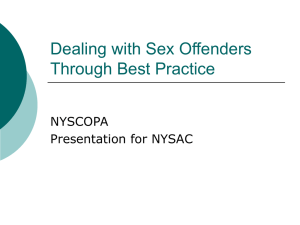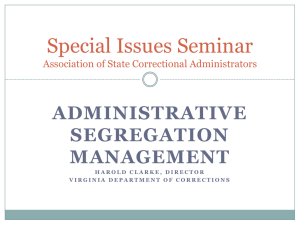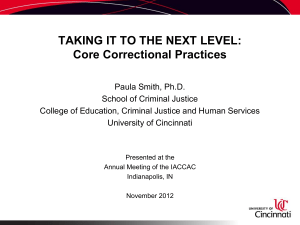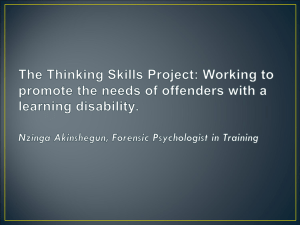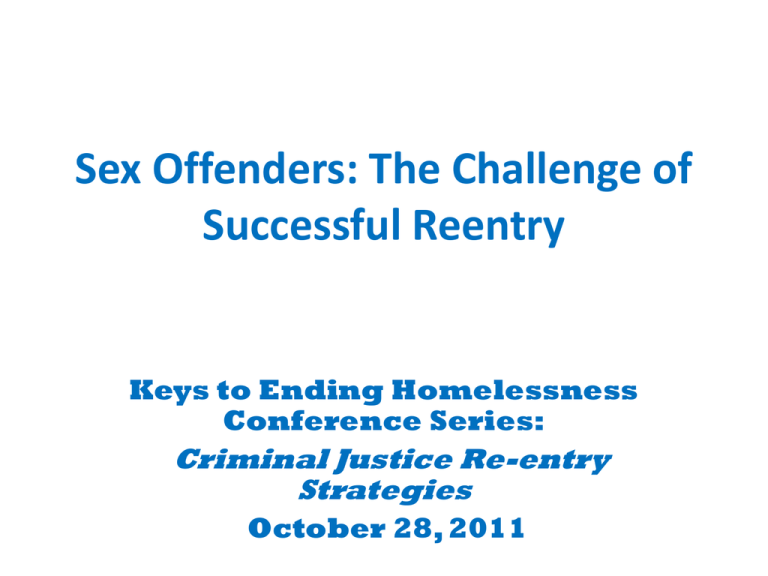
Sex Offenders: The Challenge of
Successful Reentry
Keys to Ending Homelessness
Conference Series:
Criminal Justice Re-entry
Strategies
October 28, 2011
Sex Offenders and Reentry
• James M. Byrne, PhD, Professor Criminal Justice
and Criminology University of Massachusetts
Lowell
• William H. Fisher, PhD, Professor of Criminal
Justice and Criminology at University of
Massachusetts Lowell and Professor Psychiatry
,University of Massachusetts Medical School
• Charles McDonald, Director of Communications
MA Sex Offender Registry Board
• Carlos Mercado, Detective, Lowell Police
Department
What do we currently know about sex
offenders and reentry?
• Changing Sex Offender Profile
• Changing Sex Offender Reentry Policies
• Reentry and the Role of Sex Offender
Registries
• Reentry, Sex Offenders, and Evidence-based
Practices
Trends in Sex Crime Levels, Location and
Offender Arrest/Prosecution
• Reported crime: Despite the media attention to sex abuse in the
Catholic Church, internet solicitation of minors on To Catch A Predator, and the
recent stranger abduction /assault cases involving Elizabeth Smart and Jaycee Lee
Dugart, sex crime has been on the decline over the past two decades, mirroring
the overall decline in violence in this country since the early 90’s.
• Sex Crime Locations: About 40% of sexual assaults take place in
the victim’s own home, and 20% take place in the home of a friend, neighbor or
relative .
• Arrests and Prosecution: New categories of sex defendants are
entering our federal and state court systems, due to new laws , while new Federal,
state, and local law enforcement initiatives appear to have increased both sex
crime reporting and clearance rates.
Sentencing, and Control of Sex
Offenders
• Sentencing: Compared to a decade ago, sentences for convicted sex offenders
are now more likely to include incarceration, but the majority(60%) of all
convicted sex offenders are currently in the community corrections system.
• Re-Offending: Sex Offenders are not a homogeneous group in terms of
recidivism risk, but overall, sex offenders pose the lowest risk of re-offending of all
offender groups. The U.S. Department of Justice found that over a three year
period after being released from prison, 5.3% of sex offenders were rearrested for
a new sex crime (Bureau of Justice Statistics, 2003).
• Risk vs. Stakes: Sex offenders appear –as a group—to be low risk for new
criminal behavior, but decisions regarding sex offenders are perceived to carry high
stakes for community residents, legislators, and corrections officials
The Community Control of Sex
Offenders: New Initiatives
Lifetime Supervision: Legislation has been passed allowing lifetime
probation or parole supervision for convicted sex offenders in twenty six states; in
these jurisdictions, GPS monitoring of offender location and movement is also the
norm.
New Classification and Reporting Procedures: Adam Walsh Act
requirements –if implemented fully—will increase the size of the registered sex
offender population, and mandate uniform offense-driven reporting requirements.
To date, only a small number of states have substantially met these requirements.
Residency Restrictions: Many jurisdictions have passed legislation that
restricts registered sex offenders from living near schools, parks, libraries, bus
stops, and other places where children congregate.
Monitoring the Homeless Sex Offender Population: Due to
residency restrictions, a growing number of sex offenders are registering as
homeless, which requires new strategies for monitoring this subgroup of registered
sex offenders.
Estimates of the Size of the Missing/
Noncompliant Sex Offender Problem
• National Compliance Estimates by NCMEC: There
are approximately 100,000 sex offenders
currently not in compliance with sex offender
registration/notification requirements. These
estimates are based on telephone survey data,
which raises reliability concerns.
• Compliance rates are likely to vary both within
and across states, due to a variety of factors,
including (1)resources,(2) qualifications of
personnel ,(3) monitoring frequency, and (4)
access to technology.
Can Hot Spots Locations For Registered
Sex Offenders Be identified?
• No research has been conducted to date on
whether sex offenders are locating in jurisdictions
where reporting requirements and/or monitoring
strategies are more lenient.
• It is also possible that registered sex offenders are
locating/ clustering in those areas without
residency restrictions for sex offenders.
• In the following Ohio illustration, it is apparent
that registered sex offenders are clustered in a
small number of Ohio Counties
Mapping Registered Sex Offender
Locations: An Ohio Illustration
Implications for Policy: Intended vs.
Unintended Consequences
• We may be exaggerating the extent of the missing sex offender
problem, and the threat posed by registered sex offenders.
• The Adam Walsh Act’s classification system –based on offense type
rather than risk assessment—may result in over-classification and
unnecessary costs.
• New legislation limiting sex offender residence may have
unintended negative consequences for both offenders( e.g.
homelessness) and communities( e.g. victimization).
• New Lifetime supervision legislation may be cost prohibitive, with
little impact on offender recidivism.
• The utilization of private for profit companies in sex offender
location may prove costly, and may raise privacy concerns.
Registered Sex Offenders in Lowell
• 49 registered sex offenders reside in Lowell,
Massachusetts
• 5 are currently homeless; 5 are in the shelter
on Middlesex Streets
• 3 are in violation/missing
• Registered Sex Offenders cluster in two
locations( Appleton and Middlesex Streets)
• Transitional housing will continue to be
needed in Lowell





